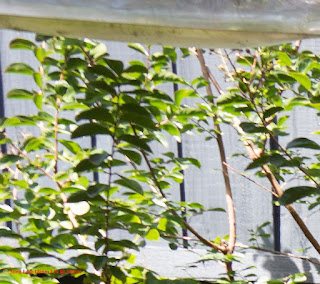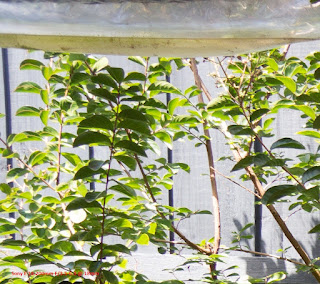Pictured below is the 10-18mm F/4 mounted on a Sony NEX-7.
The lenses that it will be compared to today, are the:
- Sony E-mount 18-200mm F/3.5-6.3 Super Zoom @ 18mm
- Sony E-mount 16mm F/2.8 Prime, with and without the VCL-ECU1 (0.75x converter)
18mm View - Full Scene
First up, the comparison at 18mm (or 16mm for the prime). Click on each photo for larger view.
At the full scene scale, there are some obvious differences. First up, of course the 16mm lens will be giving a slightly wider view. Both the 10-18mm and the 16mm give a pretty similar image, while the 18-200mm shows a lot more barrel distortion (where the centre of the photo appears to be bulging out). However, a clear winner in sharpness is also the 18-200mm, which is much more obvious in the cropped comparison below.
18mm View - Centre Crop
Below we look at a 100% crop near the centre of the frame.
The 10-18mm is a bit blurry, while both the 18-200mm zoom and the 16mm prime do a decent job at sharpness. The 16mm appears to be a little bit more crisp than the 18-200mm, but it's hard to judge whether this is actual sharpness, or rather the fact that things are a little bit smaller here (due to the 16mm POV compared to 18mm) making them appear sharper.
18mm View - Corner Crop
In a comparison of the 100% crop at the top-left corner, the 18-200mm has a significant edge in sharpness. Both the 10-18mm and the 16mm are completely blurry. Again, click on each photo for a larger view.
Here, I am especially impressed by the sharpness of the 18-200 super zoom. The leaves on the tree are sharp, and this is a 100% zoom on a 24 megapixel APS-C camera, which would be very demanding on a lens.
I'd also point out disappointment in the 10-18mm zoom, as the sharpness is even worse than the 16mm. I guess that while the 16mm is not known for its image quality, a prime lens is still easier to make than an ultra-wide zoom.
Also note that the 16mm is not cropped to the extreme corner like the other 2 lenses, since the overall image was wider and I wanted to crop to the same view.
12mm View - Full Scene
Next, let's look at the performance at the wider end, which is really the reason why anyone would buy the 10-18mm lens anyway. For obvious reasons, the 18-200mm superzoom is excluded from this part, so the comparison is limited to the 16mm F/2.8 with the VCL-ECU1 0.75x wide converter which gives an equivalent view of 12mm.
There doesn't seem to be a lot to separate out these two lenses when viewing the full scene at 1600 pixel wide scale (ie, resized for internet consumption). From my eye, I think there is an edge in sharpness for the 10-18mm over the 16mm + converter. This is apparent in the centre trees, and also the wooden deck. The 10-18mm at 12mm also appears to be a tiny bit wider than the 16mm with converter.
12mm View - Centre Crop
As above, we have a closer look with 100% crops in the centre of the frame and the top-left corner.
Not a lot to separate the two lenses at a centre crop, where most lenses tend to perform the best. I'd pick the 10-18mm as being the sharper of the two, but the differences are not hugely apparent.
12mm View - Corner Crop
If I had to choose a favourite, I'd go with the 10-18mm, but really there's very little to separate the two lenses at a 100% crop in the corner. The flower seems quite similar, but I'd argue that the leaves in the bottom right corner of the crop are sharper in the 10-18mm.
For the sake of completeness, here's also a shot of the same scene at 10mm on the 10-18mm zoom.
Conclusions
In conclusion, the 10-18mm wide angle zoom is not perfect optically, but when you want an ultrawide angle zoom lens native on a Sony NEX system, this is the only choice. The performance at the wide angle definitely beats the 16mm prime with wide converter, but that is a much cheaper alternative. At the 18mm focal length, the 18-200mm superzoom would be the obvious choice for sharpness.
However, I also find that when you're shooting at extreme wide angles, having a zoom is very handy. In this focal length range, a small change in focal length has a huge impact on your composition and framing, so I definitely prefer having the convenience of a zoom as well as being able to walk closer or further from the subject.
However, I also find that when you're shooting at extreme wide angles, having a zoom is very handy. In this focal length range, a small change in focal length has a huge impact on your composition and framing, so I definitely prefer having the convenience of a zoom as well as being able to walk closer or further from the subject.



















I could be mistaken but it appears that the left side of the full scene 10-18 images are less sharp than the right. Could the lens be decentered?
ReplyDeleteI found this helpful - trying to decide if the 10-18 is worth the money over the 16+converter. Thanks.
ReplyDeleteI am using Zeiss zoom lens on my Nex 6, I thought of buying the 10-18mm Sony wide angle lens. But I think the image is not up to par compare to my Zeiss lens. If that happen. I will shy away from the sony lens. The only reason I buy Sony because a Zeiss lens can interface to it. Most Sony Auto function are silly. When I select landscape mode it select a f4. don't you think it is silly. Sony also know that, that is why they incorporate the Zeiss lens. if not, who will buy Sony. Not me.
ReplyDeleteI am using Zeiss zoom lens on my Nex 6, I thought of buying the 10-18mm Sony wide angle lens. But I think the image is not up to par compare to my Zeiss lens. If that happen. I will shy away from the sony lens. The only reason I buy Sony because a Zeiss lens can interface to it. Most Sony Auto function are silly. When I select landscape mode it select a f4. don't you think it is silly. Sony also know that, that is why they incorporate the Zeiss lens. if not, who will buy Sony. Not me.
ReplyDeleteI have the 10-18. I found it a hard choice based on the annoyingly high price (compared to say, a Canon 10-18 which is excellent even when not regarding the price), but I got it anyway. Partly because the center is very sharp. What I mean to say is, the reason I post a reply here, is because I have not seen a single picture from it (on my Sony 6000) that looks even remotely as blurry as some of the crops I've looked at here. The 18mm center crop (leaves in shade) for example - if that was what I'd got from my lens, I'd not even consider keeping it, even if it was $300.
ReplyDeleteAny lens design is a compromise, which is why any test that rightly tries to compare some lenses will be imperfect as well, unless the lenses are very similar in purpose and design. The 10-18 for example, would score excellent across the frame around 12mm, f/5,6, focussing on anything not too close. This results in almost prime-like sharpness, which is no surprise, given that it's design around that focal length. 10mm will give worse corners, 18mm will give worse anything. 18mm is also the only focal length where I feel f/8 is required for maximum performance.
Having said that, still not getting the softness seen here. Are you sure OSS was turned off? The 10-18 genuinely fails when OSS is on, while the camera is static, on a tripod. Also, on 18mm, the difference between f/4 and f/5.6 is HUGE. As in day and night. It is designed for medium to bright applications, such as landscapes, interiors, architecture. Applications which require across-the-frame sharpness and as such typically require a stopped down lens.
I just wanted to drop my $.02 here, as I just don't recognize the softness seen here, not even when used on what is certainly the least flattering use case possible for the 10-18: on f/4 18mm + OSS + tripod.
I would literally bet, that even an 18mm-equivalent crop+blowup from 12mm / f/5.6 / OSS / handheld will be sharper.
Thanks for the comments, and apologies for the late response as I didn't realise there were new comments on this post.
ReplyDeleteI'm fairly certain OSS was disabled for these test shots, but I don't think the EXIF data records that bit of information so I can't confirm now. You are right in that the focal length and aperture combinations I selected must have tested the lens at its least flattering performance.
As other comments pointed out earlier, there's also a possibility that my copy of the lens was below average as well.
Thanks for offering your thoughts, much appreciated.
Hi! What wrist strap do you use? looks cool
DeleteHi Ronnie, thanks for your comment. That wrist strap is from DSPTCH, you can find it in various colours from https://www.dsptch.com/collections/wrist
Delete